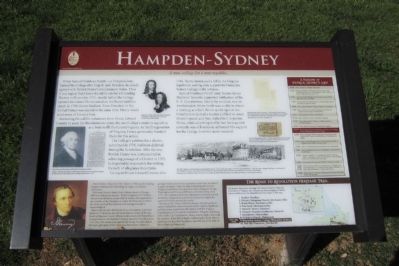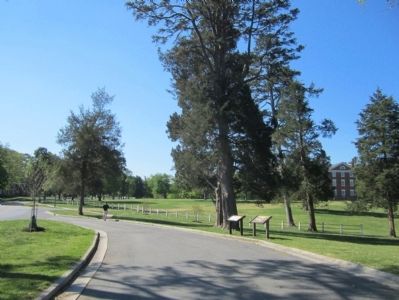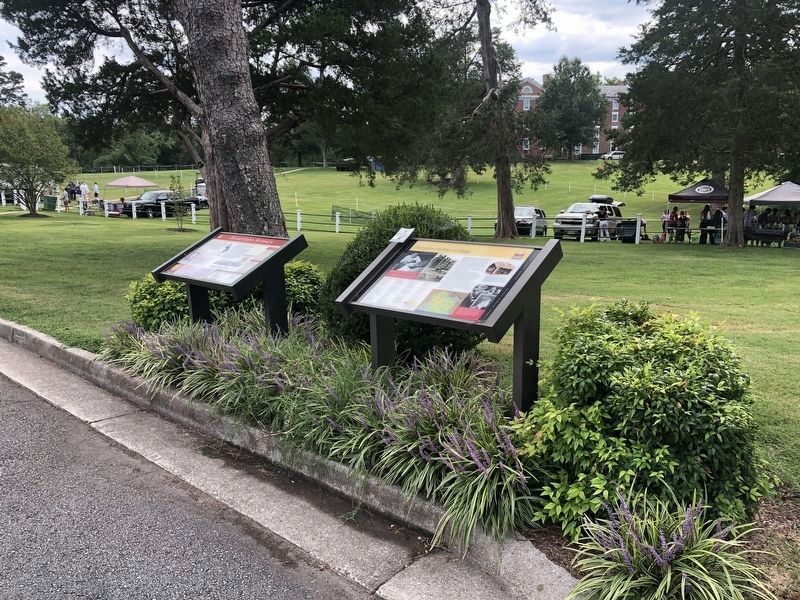Near Farmville in Prince Edward County, Virginia — The American South (Mid-Atlantic)
Hampden-Sydney
A new college for a new republic.
When Samuel Stanhope Smith, our first president, named the College after English anti-Royalists, he clearly agreed with Patrick Henry’s revolutionary vision. Thus it was logical that Henry should be elected a Founding Trustee in November 1775, shortly before the College opened for classes. He remained on the Board until his death in 1799. James Madison (later President of the United States) was elected at the same time. Henry would send seven of his sons here.
Answering the call for volunteers from Prince Edward County to assist the Revolutionary army, the new College’s students signed up as a body to fill the County’s quota. As the first governor of Virginia, Henry personally thanked them for this action.
The College’s petition for a charter, submitted in 1775, had been deferred during the Revolution. After the war, Patrick Henry was instrumental in achieving passage of a Charter in 1783; he is probably responsible for writing the oath of allegiance it contains.
Living in Prince Edward County after 1784, Henry introduced a bill in the Virginia legislature, seeking state support for Hampden-Sydney College; it did not pass.
Samuel Stanhope Smith (and Trustee James Madison) fervently supported ratification of the U.S. Constitution; Henry, by contrast, was an Antifederalist. When Smith was unable to attend a meeting at which Henry spoke against the Constitution, he had a student publicly re-enact Henry’s speech and then replied to it in person. Henry, while admitting that he had been quoted correctly, was still seriously affronted. His support for the College, however, never wavered.
(sidebar)
Patrick Henry (May 29, 1736 – June 6, 1799) was the leading Virginia statesman in defending the rights of Colonial Americans.
Following Henry’s death, John Adams wrote to Thomas Jefferson singing his praises: “In the Congress of 1774 there was not one member, except Patrick Henry, who appeared to me sensible of the Precipice or rather the Pinnacle on which he stood, and had the candour and courage enough to acknowledge it.”
Henry was the first elected governor of Virginia, a devoted father of 17 children, and the most famous orator of his day. Born in Hanover County, Henry made a name for himself as a young lawyer in the Parsons’ Cause at Hanover Courthouse in 1763. His 1765 resolutions against the Stamp Act articulated the basic principles of the American Revolution. Henry is perhaps best known for his immortal words “Give me liberty or give me death,” which he delivered during the Second Virginia Convention in a speech to fellow delegates George Washington and Thomas Jefferson at St. John’s Church in 1775. His impassioned
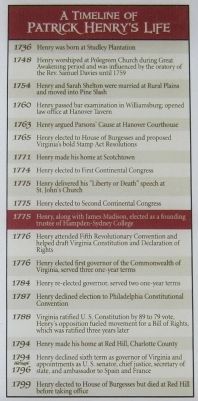
April 12, 2012
2. A Timeline of Patrick Henry’s Life
1736 Henry was born at Studley Plantation
1748 Henry worshipped at Polegreen Church during Great Awakening period and was influenced by the oratory of the Rev. Samuel Davies until 1759
1754 Henry and Sarah Shelton were married at Rural Plains and moved into Pine Slash
1760 Henry passed bar examination in Williamsburg; opened law office at Hanover Tavern
1763 Henry argued Parsons’ Cause at Hanover Courthouse
1765 Henry elected to House of Burgesses and proposed Virginia’s bold Stamp Act Resolutions
1771 Henry made his home at Scotchtown
1774 Henry elected to First Continental Congress
1775 Henry delivered his “Liberty or Death” speech at St. Johns Church
1775 Henry elected to Second Continental Congress
1775 Henry, along with James Madison, elected as a founding trustee of Hampden-Sydney College
1776 Henry attended Fifth Revolutionary Convention and helped draft Virginia Constitution and Declaration of Rights
1776 Henry elected first governor of the Commonwealth of Virginia, served three one-year terms
1784 Henry re-elected governor, served two one-year terms
1787 Henry declined election to Philadelphia Constitutional Convention
1788 Virginia ratified U.S. Constitution by 89 to 79 vote, Henry’s opposition fueled movement for a Bill of Rights, which was ratified three years later
1794 Henry made his home at Red Hill, Charlotte County
1794 through 1796 Henry declined sixth term as governor of Virginia and appointments as U.S. senator, chief justice, secretary of state, and ambassador to Spain and France
1799 Henry elected to House of Burgesses but died at Red Hill before taking office
1748 Henry worshipped at Polegreen Church during Great Awakening period and was influenced by the oratory of the Rev. Samuel Davies until 1759
1754 Henry and Sarah Shelton were married at Rural Plains and moved into Pine Slash
1760 Henry passed bar examination in Williamsburg; opened law office at Hanover Tavern
1763 Henry argued Parsons’ Cause at Hanover Courthouse
1765 Henry elected to House of Burgesses and proposed Virginia’s bold Stamp Act Resolutions
1771 Henry made his home at Scotchtown
1774 Henry elected to First Continental Congress
1775 Henry delivered his “Liberty or Death” speech at St. Johns Church
1775 Henry elected to Second Continental Congress
1775 Henry, along with James Madison, elected as a founding trustee of Hampden-Sydney College
1776 Henry attended Fifth Revolutionary Convention and helped draft Virginia Constitution and Declaration of Rights
1776 Henry elected first governor of the Commonwealth of Virginia, served three one-year terms
1784 Henry re-elected governor, served two one-year terms
1787 Henry declined election to Philadelphia Constitutional Convention
1788 Virginia ratified U.S. Constitution by 89 to 79 vote, Henry’s opposition fueled movement for a Bill of Rights, which was ratified three years later
1794 Henry made his home at Red Hill, Charlotte County
1794 through 1796 Henry declined sixth term as governor of Virginia and appointments as U.S. senator, chief justice, secretary of state, and ambassador to Spain and France
1799 Henry elected to House of Burgesses but died at Red Hill before taking office
Known as the “Voice of the Revolution,” Henry’s political career included 26 years of service in the Virginia legislature and five terms as governor. He helped draft the Virginia Constitution of 1776 and its Declaration of Rights. A leading critic of the U.S. Constitution, Henry also strongly influenced the creation of the Bill of Rights. Following his death, Henry was buried at Red Hill Plantation, now the site of the Patrick Henry National Memorial.
Erected by The Road to Revolution Heritage Trail. (Marker Number 9.)
Topics and series. This historical marker is listed in these topic lists: Colonial Era • Education • Patriots & Patriotism • War, US Revolutionary. In addition, it is included in the Former U.S. Presidents: #02 John Adams, the Former U.S. Presidents: #03 Thomas Jefferson, and the Former U.S. Presidents: #04 James Madison series lists. A significant historical date for this entry is June 6, 1895.
Location. 37° 14.692′ N, 78° 27.614′ W. Marker is near Farmville, Virginia, in Prince Edward County. Marker is on College Road (County Route 692) 0.3 miles south of Five Forks Road (County Route 658), on the right when
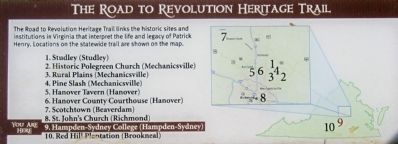
April 12, 2012
3. The Road to Revolution Heritage Trail
The Road to Revolution Heritage Trail links the historic sites and institutions in Virginia that interpret the life and legacy of Patrick Henry. Locations on the statewide trail are shown on the map.
1. Studley (Studley)
2. Historic Polegreen Church (Mechanicsville)
3. Rural Plains (Mechanicsville)
4. Pine Slash (Mechanicsville)
5. Hanover Tavern (Hanover)
6. Hanover County Courthouse (Hanover)
7. Scotchtown (Beaverdam)
8. St. John’s Church (Richmond)
9. Hampden-Sydney College (Hampden-Sydney)
10. Red Hill Plantation (Brookneal)
1. Studley (Studley)
2. Historic Polegreen Church (Mechanicsville)
3. Rural Plains (Mechanicsville)
4. Pine Slash (Mechanicsville)
5. Hanover Tavern (Hanover)
6. Hanover County Courthouse (Hanover)
7. Scotchtown (Beaverdam)
8. St. John’s Church (Richmond)
9. Hampden-Sydney College (Hampden-Sydney)
10. Red Hill Plantation (Brookneal)
Other nearby markers. At least 8 other markers are within walking distance of this marker. Hampden-Sydney College (a few steps from this marker); About Hampden-Sydney College (within shouting distance of this marker); Everett Stadium (within shouting distance of this marker); Tyrus Raymond Cobb (about 700 feet away, measured in a direct line); September 11 Memorial (approx. 0.2 miles away); Vietnam War Memorial (approx. 0.2 miles away); Korean War Memorial (approx. 0.2 miles away); Roll of Honor (approx. 0.2 miles away). Touch for a list and map of all markers in Farmville.
More about this marker. On the left are portraits of "Algernon Sidney (left) and John Hampden, the English revolutionaries for whom Smith named the College."
On the lower left are "[left] Samuel Stanhope Smith, the founding president" and "[right] Samuel Stanhope Smith’s advertisement in the Virginia Gazette, announcing the founding of the College, September 1775."
On the right are "Reproduction of the Charter of 1783, which Patrick Henry was instrumental in procuring for the College and for which he probably wrote the oath of loyalty to the new republic. Reproduction by John L. Brinkley ’59." and "Fund-raising lottery ticket — the first government-sanctioned lottery to benefit higher education in America. As a trustee, Patrick Henry would have authorized this."
On the right is a sketch with the caption, "The Old College, as Patrick Henry would have known it. Construction was begun in 1775 and completed in 1776. The main college building is at center, with the President’s House to the right and the Steward’s House (dining hall) to the left, accompanied by various outbuildings. Drawing by N. Douglas Payne ‘95, based on a model by Richard McClintock in the Atkinson Museum of Hampden-Sydney."
Also see . . . Hampden-Sydney College. (Submitted on April 15, 2012.)
Credits. This page was last revised on November 11, 2021. It was originally submitted on April 15, 2012, by Bernard Fisher of Richmond, Virginia. This page has been viewed 720 times since then and 25 times this year. Photos: 1, 2, 3, 4. submitted on April 15, 2012, by Bernard Fisher of Richmond, Virginia. 5. submitted on September 6, 2021, by Devry Becker Jones of Washington, District of Columbia.
